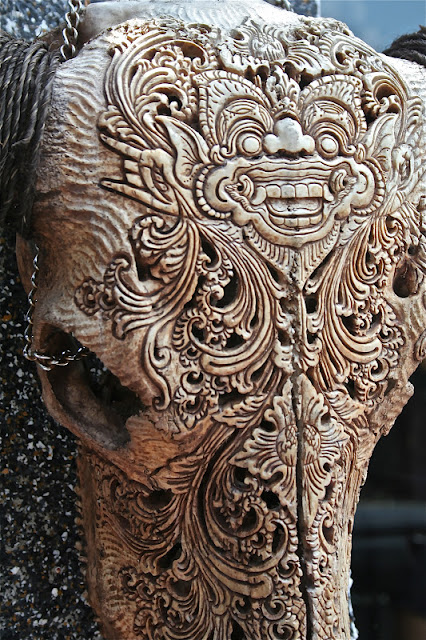 |
| One of the rooms at our hotel, the Tjampuhan. The restaurant is at left. A gorgeous setting. |
 |
| The view from our balcony |
 |
| Nature is the template for the design of Tjampuhan |
 |
| One of the spring-fed swimming pools |
Despite the economic drawbacks of being a tourist, Bali is a charming place. The jungle is always nearby, rushing streams run through the middle of Ubud at the base of cliffs with lush vegetation clinging to the rocks; brilliant butterflies, swooping swallows and bats flit through the garden-like village.
 |
| A hotel worker ceremoniously places incense, holy water and flowers on a shrine. |
 |
| Every day a fresh offering is placed on a special box beside each door of the hotel rooms. This was ours. |
 |
| Placing offerings on a shrine at a shop in town. |
 |
| This woman spent an hour placing flowers and incense around one of Ubud's temples. |
 |
| Baskets are found everywhere, hundreds on the sidewalks of Ubud. |
 |
| It is common to see people taking huge baskets of fruit to the temples at all hours. |
 |
| Offerings at a shrine in Ubud |
 |
| 15th century cave temple, Goa Gajah (Elephant Cave). |
 |
| Entrance to Goa Gajah |
 |
| The meditation room of the royal family from the Majahapit Empire. |
Outside of town, villages, with temples at their centers, remain the cultural fiber of Bali. Each Balinese village has three temples, one for each of the main Hindu gods: Brahma (the creator), Vishnu (the preserver), and Shiva (the destroyer). To see Balinese life, one must venture beyond the tourist centers. We spent a full day touring the countryside, visiting ancient temples, dining at the base of an active volcano, and observing everyday life of villagers and farmers.
 |
| Entrance to a village temple. |
 |
| Holy springs at temple in Sebatu Village. |
 |
| Altar detail |
 |
| Everyone must wear a sarong at temples. There are always sarongs to borrow as you enter. |
 |
| Part of Bali's vast irrigation system. |
 |
| Bali's famous rice paddy terraces |
 |
| Roadside fruit stand |
 |
| Winnowing rice at harvest time |
 |
| Mt Batur. The damage from the 1963 eruption can still be seen on its slopes and in the tongue of the lava flow in middle of the photo. |
 |
| A selection of Balinese coffees. The white cup in the middle contains luwak coffee, the beans of which have traveled through the digestive tract of a civet cat. |
Returning to Ubud, we took time to stroll the streets, take in some cultural events, and relax in the beauty of the lush surroundings.
 |
| An artist captures the beauty and grace of the Balinese |
 |
| There's that phallic obsession again. This time, it is a wooden call bell on our balcony. Each room has one. |
 |
| Balinese women carry a variety of things on their heads. Men never do: they use their shoulders to bear the weight. |
 |
| Some of the loads are quite imposing. |
 |
| Recess time at a local school |
 |
| Even the macaques at Monkey Forest let it all hang out! |
 |
| A gamalan band performs at the palace in Ubud. |
 |
| Traditional Balinese dancers. |
 |
| From a version of the Ramayana legend, performed at the palace. |
 |
| School entrance |
 |
| Palace wall carvings |
 |
| Traditional Balinese figures |
 |
| Lush sanctuaries are tucked away inside courtyards. |
 |
| Mythical demon carvings beautifully rendered on a cow skull |

2 comments:
Fine photography combined with illuminating text!
Good to see you enjoyed yourself in Bali, John. It can be a lovely place. The phallic carvings aren't found outside the tourist areas, except for the ancient ones. Sexuality in Bali has an interesting place in hearts and minds, but not out in the open. Balinese still find tourist who wander around half-dressed to be something to giggle about as they seem to be without good manners.
Post a Comment